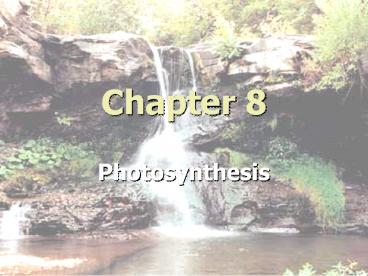Photosynthesis PowerPoint PPT Presentation
1 / 18
Title: Photosynthesis
1
Chapter 8
- Photosynthesis
2
8-1 Energy and Life
- All organisms must be able to produce energy from
the environment in order to live. - Where do we get our energy???
- What is the Ultimate energy source???
3
- ATP (energy storage molecule)
- Adenosine Tri-Phosphate
- Similar to Gasoline!!!
- Energy is stored in the bonds!!
A
1st 2nd 3rd
P
P
P
Bonds
4
ATP
- Making of ATP
- ADP P Energy ? ATP
- Breaking down of ATP
- ATP ? ADP P Energy
5
8-2 Photosynthesis Trapping the Suns Energy
- Photo synthesis
- Photosynthesis Converts the energy of sunlight
into chemical energy stored in the bonds of
glucose (C6H12O6) and oxygen - 6 CO2 6 H2O ? C6H12O6 6 O2
- CARBON DIOXIDE WATER
GLUCOSE OXYGEN -
(PLANT FOOD)
(PLANT POOP) -
6
- 6 CO2 6 H2O ? C6H12O6 6 O2
- 1. Light
- 2. Enzymes
- 3. Chlorophyll
- CO2 H2O are Raw Materials!
- C6H12O6 O2 are Products!
7
(No Transcript)
8
There are two types of organisms
- Autotrophs
- Make their own food (photosynthesis /
chemosynthesis) - Most are plants!
- Heterotrophs
- Eat other organisms
- We are heterotrophs
9
2 Parts to Photosynthesis
- Light-dependent Reaction
- Requires Light
- Photolysis
- H2O
- Makes Oxygen
- Light-independent Reaction
- Also called Calvin Cycle or Dark Reaction
- Does not require Light
- Makes Glucose
10
Chemosynthesis (pg. 68)
- Not all autotrophs use the sun for energy.
- Some autotrophs use chemicals through a process
call chemosynthesis - Tube worms are an example of organisms that use
chemosynthesis.
11
Chapter 9
- Cellular Respiration
12
9-1 Chemical Pathways
- How much energy is actually present in food?
- A LOT One gram of glucose C6H12O6 when burned
releases 3811 calories of heat energy - Calorie the amount of energy needed to raise 1
gram of water 1 degree Celsius - Big C we see on food labels represents a
kilocalorie (1000 calories)
13
Glycolysis
- The breaking down of glucose to release energy!
- Glycolysis releases a small amount of energy (1
glucose 2 ATP) - IF oxygen is present, glycolysis leads to two
pathways that release a great deal of energy. - IF oxygen is absent, glycolysis leads to a
different pathway.
14
Cellular Respiration
- In the presence of oxygen, glycolysis is followed
by the Krebs cycle the electron transport
chain. - Glycolysis, the Krebs cycle, the elctron
transport chain make up a process called CELLULAR
RESPIRATION!!
15
Cellular Respiration Equation
C6H12O6 6 O2 ? 6 CO2 6 H2O Energy
16
Two types of Respiration
- Aerobic ? Requires Oxygen
- More Energy
- Anaerobic ? Does Not Require Oxygen
- Less Energy
17
Two types of fermentation
- Lactic Acid Fermentation
- Anaerobic
- End product, Lactic Acid
- Alcoholic Fermentation
- Anaerobic
- End product, alcohol
18
Compare cellular respiration and photosynthesis
Photosynthesis Cellular Respiration
Function Energy Capture Energy Release
Location Chloroplasts Mitochondria
Reactants CO2 H2O C6H12O6 O2
Products C6H12O6 O2 CO2 H2O

